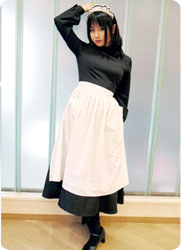「秋葉」 used to be Tokyo’s biggest electronic district. I say, “used to” because it has been steadily turning into something shadier over the years.
「秋葉」(short for 「秋葉原」) is pretty much a geek’s paradise. There are all sorts of games and electronic stores including the massive 「ヨドバシカメラ」, which was newly built not too long ago.
Well, it turns out that there are two different categories of geeks: the technology geek and the creepy geek. 秋葉 used to be for the technology geeks, guys who were into gadgets, software, and hardware. But it turns out many geeks have interests in another realm, which I can only describe as “shady”.
I go through 秋葉 everyday on my commute but I decided to take my commuter’s pass, go over there on a weekend, and actually look around and explore the neighborhood. What I found out was that probably about half of the businesses there now cater to the “dark side” of the geek population.
First of all, there were mountains of porn. What looked like perfectly normal stores would suddenly have a whole floor for porn. Some stores had a whole floor just for animated porn. Scratch that, some stores were for animated porn! You can’t find this kind of selection for this type of stuff anywhere else in the world. (Incidentally, just to be clear, I didn’t actually look around or purchase anything. In fact, I didn’t even go inside, I could pretty much tell what it was from the staircase. Just to be clear.)
Besides the monumental amount of porn, 秋葉 is increasingly turning more fetish-like. I can’t explain this any better than saying one word: 「萌え」. 「萌え」 is kind of like “ubuntu” in that it represents a whole concept and therefore doesn’t have any specific definition. The similarity totally ends there though. Let’s see what we can find out about this word on the net.
(If you want to learn more about 「萌え」, you can also check out the Japanese wikipedia entry on 「萌え」. It’s so extensive, it’s practically a research paper.)
萌えとは
一般に「架空のキャラクターに対する愛情」として理解されることが多い。が、マスコミ的にはオタク全般に対するイメージと合わさり、歪んだ伝搬をされることもしばしばである。なぜか萌え=メイドさん、のニュアンスが付加されるなど。
(from はてな)
「なぜか萌え=メイドさん」 Ahh yes, the maids. As a fellow male, I just cannot understand the attraction of maids. I mean, these maid costumes completely cover the body with layers and layers of clothing. Yawn. And yet 秋葉 has totally been taken over by maid cafes, called 「メード喫茶」, for reasons beyond my comprehension. Let’s take a look at this list of maid cafes. CURE MAID CAFE in 秋葉原、ひよこ家 in 秋葉原、Cafe Mai:lish… 秋葉原、Cos-Cha hmm… 秋葉原? 秋葉原 isn’t even that big a place but I bet the list doesn’t even come close to covering all the maid cafes in 秋葉原.

Cuter without the maid costume?
(from Cafe Mai:lish)
Worse, the maids have started branching into other industries such as 萌バーガー, a burger shop and even a hair salon called moesham. (Notice the use of 「萌え」 in both store names)
The 萌え phenomenon and 2ちゃんねる* have spawned a new class of vocabulary. My favorite is 「ツンデレ」, which comes from 「ツンツン」 and 「デレデレ」. I love it because, Yahoo, of all the places, has the funniest definition ever.
ツンデレ (つんでれ)
アニメや漫画のキャラクターの傾向を表す語。普段はツンツンしているヒロインが、恋人と2人きりになるとデレッとかわいくなること。アニメの主人公のキャラクターとして求めていたものだが、実際に自分が付き合う女性に対しても、こうした性格を求めるようになっている。ツンツンして取っつきにくいのに、付き合いを始めると実はしおらしくていつの間にかデレデレとしてくることを求めるのである。しかし、現実にはそうした二面性をもった女性を、オタクの男性がゲットすることはきわめてむずかしいとみられる。
(from Yahoo!辞書)
Basically, 「ツンデレ」 characterizes a common manga/anime female character who is aloof and cold (ツンツン) but becomes all lovey-dovey (デレデレ) when she is alone with the boy she likes. The definition above explains it much better though. The last sentence is the best because it’s worded so seriously and yet is a total smackdown on the オタク nerds who have no real chance with such a girl.
I’ve actually heard rumors of 「ツンデレ・カフェ」. Apparently there was a 「ツンデレ・イベント」 this March. I guess the maids are rude when you walk in and nice when you leave? Hmm… might be the next big thing.
Conclusion
I’m going to conclude here, now that I’ve managed to brilliantly turn this into a language lesson. So I’ll just put this into the “Vocabulary” category and end yet another educational post. (What? You didn’t realize that the whole point of this post was to explore the exciting Japanese language?) I’m not entirely sure if it is appropriate for the “Culture” category though.
あばよ!
*2ちゃんねる is basically the most poorly designed BBS in the history of the world. I mean, I tried using it once but had to stop because the user interface induced me into a temporary coma. The popularity of this website is yet another mystery I’ll never understand.


